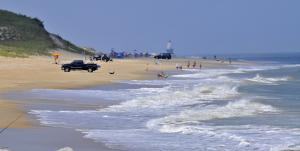If sea level rises as predicted over the next few decades, Delaware's shoreline will be completely changed. Even slight sea-level rise could be devastating in a state that relies heavily on its coast for tourism, wildlife habitat and residential development.
To heighten awareness, 11 Delaware environmental groups have joined forces in one voice to stress the state's vulnerability to sea-level rise.
The organizations support the findings of Delaware's Department of Natural Resources and Environmental Control Sea-Level Advisory Committee's vulnerability assessment, which evaluates areas where the state is at risk. The report emphasizes that every Delaware resident will be affected in some way in the future, said Wendy Scott, policy advisor for the Delaware Center of Horticulture.
“Three feet of sea-level rise would flood over 12,000 homes,” said Chad Tolman of the League of Women Voters and a member of the advisory committee.
Many of those homes would in coastal Sussex County, where up to 32 percent of manufactured homes are at risk of inundation, according to the assessment, which was released Aug. 12.
Delaware has already experienced sea-level rise in some coastal areas. The state's rate of sea-level rise rate is above the national average rate and is expected to speed up in the future, the report notes.
Using various models and calculations, DNREC officials have calculated sea-level rise in Delaware by 2100 using a minimum estimate of 1.64 feet and a maximum estimate of nearly 5 feet. Over the past 50 years, sea-level rise at a Lewes recording station has been 6 inches. DNREC officials stress that even at that rate, sea-level would rise at least 1 foot by the end of the 21st century.
The Intergovernmental Panel on Climate Change offers more dramatic predictions with a minimum sea-level rise of 7 inches worldwide to a maximum of 23 inches, or just less than 2 feet.
State's wetlands at risk
With the lowest elevation in the nation and more than 380 miles of shoreline along Delaware Bay, Delaware River, Inland Bays and the Atlantic Ocean, Delaware is particularly vulnerable to sea-level rise. At risk are industrial areas in New Castle County, future development areas in Sussex County and tourism and coastal recreation with the potential loss of significant revenue, according to the report.
More than 90 percent of the state's wetlands and coastal impoundments are subject to potential inundation, with more than 85 percent of refuge lands – or 21,000 acres – at risk from sea-level rise, according to the report. In addition, wells, septic systems, roads, bridges, wildlife habitats and farmland near the coast are at risk.
In all, the report says, 97 percent of Delaware's tidal wetlands could be affected. Scott said wetlands are vital to help filter pollution, provide habitat for fish and wildlife and absorb flood waters from storm surges, protecting nearby homes and businesses.
“The waters of the Delaware River and Bay support industry, agriculture, fisheries and tourism that put billions of dollars into our economy every year,” said Jennifer Adkins, executive director of the Partnership for the Delaware Estuary. “We rely on marshes to keep them clean and productive.”
No area of the state is more than eight miles from tidal waters, said Brenna Goggin, environmental advocate for the Delaware Nature Society. “Considering that fact, the potential affects are of great concern,” she said.
The impacts of sea-level rise would go beyond environmental issues to affect jobs and the economy. According to Sea Grant Delaware, coastal activities account for 59,000 jobs and $711 million in tax revenue. Coastal flooding puts many of those jobs and revenues at risk, Scott said.
State officials are putting on a full-court press to study the impact of sea-level rise. Several committees and sub-committees have been meeting for months to discuss and report on the issue from every conceivable angle.
The Delaware Coastal Programs website outlines how the state is tackling the issue, showing sea-level rise affects more than beaches and oceanfront land owners; it can increase the height of storm waves, making more areas vulnerable to storm damage. Sea-level rise also can cause higher water tables and salt-water intrusion, interfering with septic systems, drinking water and irrigation water.
A statewide adaptation plan is under development. When complete, the plan will recommend policy changes and practices assisting officials to make informed policy and investment decisions to prevent future damage and losses to infrastructure, resources and homes.
Resident asks county to take action
The report caught the attention of resident John Austin who sent an email to Sussex County Councilwoman Joan Deaver, D-Rehoboth Beach. He noted that from 425 to 2,748 Sussex septic systems could be inundated as could sections of the county's Wolfe Neck spray irrigation fields and from 40 to 117 of the county's pump stations.
“It seems prudent that the counties should enact zoning restrictions in the coastal zone to prevent more septic systems or other public or private sewage infrastructure in areas that are vulnerable,” wrote Austin.
Deaver read the email during the Sept. 18 meeting and received no comment from other council members.
Groups backing the assessment include Delaware Sierra Club; Delaware Greenways; Delaware Nature Society; Center for the Inland Bays; Delaware Interfaith Power and Light; Delaware Wildlands; Delaware Audubon; Delaware Center for Horticulture; League of Women Voters of Delaware; Delaware Chapter of the Nature Conservancy; and Clean Air Council.
For a copy of the report, go to: www.dnrec.delaware.gov/coastal/Documents/SLR%20Advisory%20Committee/Meeting12April2012/040612VAResultsforSLRAC.pdf.
For a look at state initiatives, go to: www.dnrec.delaware.gov/coastal/Pages/SeaLevelRiseAdaptation.aspx.

























































